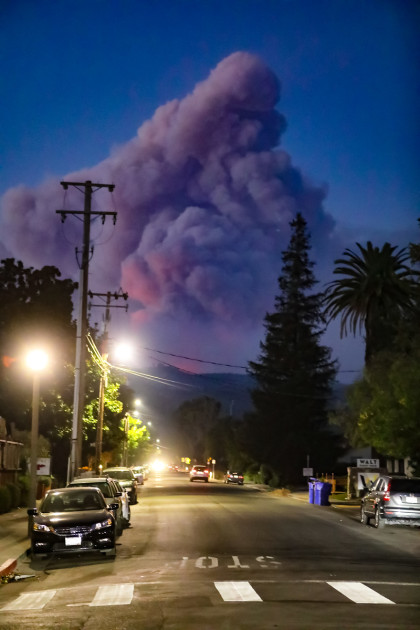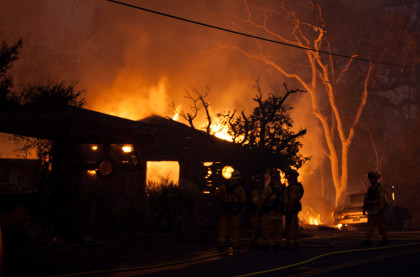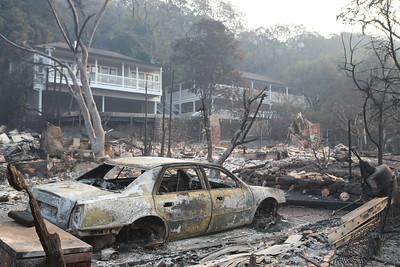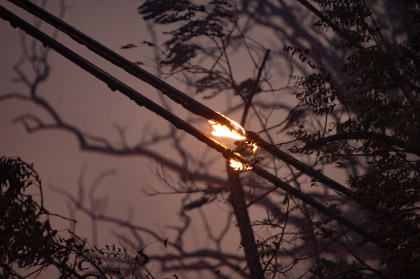A fiery California fairy tale: the imagination of disaster reborn

By Jonah Raskin | Special to The Sun
When the flames hit the fields at Old Hill Ranch in Sonoma, Will Bucklin battled them by himself, though he had not once imagined that scenario. For years, he thought that the fire department from the near-by town of Glen Ellen would arrive in the nick of time and that together they’d put out the blaze. Unfortunately, that didn’t happen. Bucklin fought the flames without help, though he hasn’t bragged about it.
He’s an unusual fellow in Sonoma County not only because he grows grapes unconventionally and makes unconventional wines, but also because he has what’s known as the “imagination of disaster.” Few citizens in Sonoma and in neighboring Napa are in the habit of conjuring images of catastrophe and disaster, at least not on ordinary mornings when they wake up, drink coffee and check their emails.
“Another sunny day in paradise,” is a comment I have often heard. I’ve made it myself.
On the seventh day of the October fire that took the lives of 40 people in Sonoma County, California and that turned another 20,000 into refugees.
In fact, there was far more than one fire, but rather a continual series of them that spread quickly all over the map. Citizens were taken by surprise; some dawdled and couldn’t save their own lives. Others didn’t know what essentials to take with them or where to go for safety, though many citizens were ingenious, and there was the herd of sheep and an Alsatian watchdog that apparently saved themselves when ranchers fled.
Most of us like stunning victories, and northern Californians are no exception.

Local newspapers and magazines habitually urge citizens to be happy and enjoy life, because they live in paradise, or so they’ve been told. Parents and teachers tell students not to catastrophize because it’s bad for one’s mental health. Psychiatrists and psychologists say much the same thing and prescribe anti-anxiety and anti-depression pills. Politicians urge their constituents to smile and be nice to one another.
The whole region seems to be in a state of denial. Days before most of the fires were extinguished, signs went up in Santa Rosa that said, “Sonoma Proud” and “The love in the air is thicker than the smoke.” Still, one couldn’t see the love, while the smoke was obvious and toxic, too. Citizens wore gas masks and stayed indoors.
In a place habitually afflicted by floods, droughts, fires and earthquakes anyone who fixated on disaster would be a very unhappy soul, indeed and for long periods of time. Perhaps the “imagination of disaster” is best left to books, movies, and video games.
Cultural critic, Susan Sontag popularized the phrase in a 1965 essay titled, “The Imagination of Disaster” that helped to bring her fame and that made the concept aesthetically attractive. She also showed that the imagination of disaster was part of popular American culture and invigorated science fiction films about alien invaders on planet earth.
Fifty-two years after Sontag’s landmark essay, the concept is the subject of a great many books, articles and scholarly conferences, though it hasn’t yet trickled down to the consciousness of ordinary citizens.
I become a fan of disaster after I read Sontag’s essay when I was in graduate school. For years, I lusted after apocalypse, doom and gloom and then once I recognized the power they held over me I made a concerted effort to keep them at bay and to look for signs of resilience around me.
Unreal disasters created by writers and directors and then projected on the page and on the screen, are easier to watch then real disasters. In a real disaster you have to react or you’ll die. In a wild fire, the couch potato and the person in screen-lock will perish in the flames.

These days, catastrophe provides the thread that connects all of us, whether we live in Texas, California, New York, Fukishima or Chernobyl. It’s now the planetary common denominator and yet everyone experiences catastrophe privately, even though we live through it as a species, and then, sadly, do little if anything to prevent it from happening again.
Indeed, this time around we didn’t clear brush ahead of time, or thin out forests where trees grow too closely together near upscale neighborhoods. We have packed houses next to one another and we have not provided enough fire hydrants in areas that are still rural, but that are also now largely residential. There isn’t a fire hydrant within a mile of my house.
Undoubtedly, fires, floods and droughts will again assault us. Undoubtedly, we will encounter extreme weather of all sorts, as well as that big bogeyman, climate change. Still, to float these ideas in a place like Sonoma — where citizens often say, “It’s all good” and mean what they say — has felt like a subversive act.
Indeed, the imagination of disaster can be a kind of thought crime in these parts, though Jack London, the most famous Sonoma author, wrote two apocalyptic books, “The Iron Heel” and “The Scarlet Plague,” the first about the coming of a dictatorship to the U.S.A, and the second about a pandemic that wipes out nearly all of humanity. London had the imagination of disaster.
He also covered the 1906 earthquake and fire that destroyed much of San Francisco. His own mansion, Wolf House, burned to the ground in 1913, shortly before he and his wife could move in, and make it their new home. They never rebuilt. This year, in the wake of the fires, Sonomans will think twice about rebuilding.
Local readers seem to prefer the novels and stories in which London tacked on happy endings to otherwise grim narratives like The Valley of the Moon, in which the two main characters arrive in Sonoma from strife-torn Oakland and think that they have discovered paradise.

One recent visitor who came here thought he’d found heaven and wanted to settle down. Then, he died in the fire.
Sonoma can seem heavenly, though it’s also a real landscape of disaster. It certainly was for the Native Americans tribes that once thrived here and who were largely destroyed in the nineteenth century by Yankee invaders and occupiers.
Those who would move here today or who come to visit and drink wine, might remember that beneath the beauty there’s a history of fire, flood, genocide and environmental destruction.
Fortunately, there are wise men and women among us who understand the depths of disaster. Lisa Vollendorf, the Provost at Sonoma State University, noted in an email to the faculty that, “While we are observing a great deal of resilience, underlying that is a deep well of uncertainty and in some cases, to be quite honest, excruciating heart ache, pain and loss.”
Honesty, along with resilience, is precisely what citizens need in the wake of the latest disaster. Now, eight days after the fires started, Sonomans are beginning to realize the extent of their heartache, pain and loss, emotional as well as physical, that will take more than brave and heroic firefighters, to heal and perhaps make whole again.
Jonah Raskin is the author of “Field Days: A Year of Farming, Eating and Drinking Wine in California”.
PHOTOS BY WILLIAM MURRAY
One thought on “A fiery California fairy tale: the imagination of disaster reborn”
Comments are closed.




This is some very good and cogent writing Jonah!
The unfettered run to rebuild in areas of high risk (Fountain Grove) recaps the same pattern in Florida and other coastal areas where seaside post-disaster home building goes on time after time. The problem is even more salient now with human-caused climate change. Weather experts see an increase in unpredictable and severe weather. In a way, it’s like a situation where some are allowed, and choose to ride with no motorcycle helmet, while the whole insurance pool has to cover the higher rates from their more severe injuries.
Wouldn’t some limits and planning ahead make more sense?
The core issue here is individual rights vs collective responsibility, or, tragedy of the commons.
What ends up happening is that individual rights/ property rights/ free market advocates have the US individualistic tradition and the money behind them. Common sense solutions are bypassed, and we end up recapping predictable disasters time after time, while a few creates costs the whole has to bear.
The biggest predicable disaster is anthropogenic climate change. Barbara Tuchman wrote a book on this general topic called The March of Folly. Why do governments display massive incompetence time after time? In the case of the US economy, why pursue “growth” at all costs
when it is clear that over-consumption is destroying natural resources needed to support the future?
So here we are right smack up against the same pattern again, with the Santa Rosa city council not having three votes for common sense. The march of folly continues on.
http://www.pressdemocrat.com/news/7572376-181/fire-scorched-fountaingrove-in-santa-rosa?artslide=0